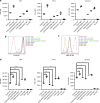Nonstimulatory peptide-MHC enhances human T-cell antigen-specific responses by amplifying proximal TCR signaling
- PMID: 30006605
- PMCID: PMC6045629
- DOI: 10.1038/s41467-018-05288-0
Nonstimulatory peptide-MHC enhances human T-cell antigen-specific responses by amplifying proximal TCR signaling
Abstract
Foreign antigens are presented by antigen-presenting cells in the presence of abundant endogenous peptides that are nonstimulatory to the T cell. In mouse T cells, endogenous, nonstimulatory peptides have been shown to enhance responses to specific peptide antigens, a phenomenon termed coagonism. However, whether coagonism also occurs in human T cells is unclear, and the molecular mechanism of coagonism is still under debate since CD4 and CD8 coagonism requires different interactions. Here we show that the nonstimulatory, HIV-derived peptide GAG enhances a specific human cytotoxic T lymphocyte response to HBV-derived epitopes presented by HLA-A*02:01. Coagonism in human T cells requires the CD8 coreceptor, but not T-cell receptor (TCR) binding to the nonstimulatory peptide-MHC. Coagonists enhance the phosphorylation and recruitment of several molecules involved in the TCR-proximal signaling pathway, suggesting that coagonists promote T-cell responses to antigenic pMHC by amplifying TCR-proximal signaling.
Conflict of interest statement
The authors declare no competing interests.
Figures









Similar articles
-
Coreceptor affinity for MHC defines peptide specificity requirements for TCR interaction with coagonist peptide-MHC.J Exp Med. 2013 Aug 26;210(9):1807-21. doi: 10.1084/jem.20122528. Epub 2013 Aug 12. J Exp Med. 2013. PMID: 23940257 Free PMC article.
-
A novel approach to antigen-specific deletion of CTL with minimal cellular activation using alpha3 domain mutants of MHC class I/peptide complex.Immunity. 2001 May;14(5):591-602. doi: 10.1016/s1074-7613(01)00133-9. Immunity. 2001. PMID: 11371361
-
Functional evidence for TCR-intrinsic specificity for MHCII.Proc Natl Acad Sci U S A. 2016 Mar 15;113(11):3000-5. doi: 10.1073/pnas.1518499113. Epub 2016 Feb 1. Proc Natl Acad Sci U S A. 2016. PMID: 26831112 Free PMC article.
-
The diversity of antigen-specific TCR repertoires reflects the relative complexity of epitopes recognized.Hum Immunol. 1997 May;54(2):117-28. doi: 10.1016/s0198-8859(97)00082-7. Hum Immunol. 1997. PMID: 9297530 Review.
-
Co-receptors and recognition of self at the immunological synapse.Curr Top Microbiol Immunol. 2010;340:171-89. doi: 10.1007/978-3-642-03858-7_9. Curr Top Microbiol Immunol. 2010. PMID: 19960314 Free PMC article. Review.
Cited by
-
T cell receptor and cytokine signal integration in CD8+ T cells is mediated by the protein Themis.Nat Immunol. 2020 Feb;21(2):186-198. doi: 10.1038/s41590-019-0570-3. Epub 2020 Jan 13. Nat Immunol. 2020. PMID: 31932808
-
T-cell Receptor Is a Threshold Detector: Sub- and Supra-Threshold Stochastic Resonance in TCR-MHC Clusters on the Cell Surface.Entropy (Basel). 2022 Mar 10;24(3):389. doi: 10.3390/e24030389. Entropy (Basel). 2022. PMID: 35327900 Free PMC article. Review.
-
Non-Stimulatory pMHC Enhance CD8 T Cell Effector Functions by Recruiting Coreceptor-Bound Lck.Front Immunol. 2021 Oct 11;12:721722. doi: 10.3389/fimmu.2021.721722. eCollection 2021. Front Immunol. 2021. PMID: 34707605 Free PMC article.
-
Targeting CAR to the Peptide-MHC Complex Reveals Distinct Signaling Compared to That of TCR in a Jurkat T Cell Model.Cancers (Basel). 2021 Feb 18;13(4):867. doi: 10.3390/cancers13040867. Cancers (Basel). 2021. PMID: 33670734 Free PMC article.
-
Time required for commitment to T cell proliferation depends on TCR affinity and cytokine response.EMBO Rep. 2023 Jan 9;24(1):e54969. doi: 10.15252/embr.202254969. Epub 2022 Nov 3. EMBO Rep. 2023. PMID: 36327141 Free PMC article.
References
Publication types
MeSH terms
Substances
Grants and funding
LinkOut - more resources
Full Text Sources
Other Literature Sources
Molecular Biology Databases
Research Materials

